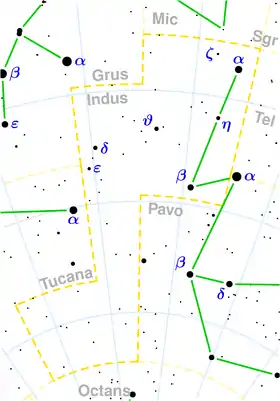印第安座ε
印第安座ε星(Epsilon Indi)位於印第安座,距離地球11.83光年。印第安座ε星的自行運動速度在肉眼可見的恆星中排名第2,僅次於天鵝座61(不過自行運動比印第安座ε星大的葛羅姆布里吉1830亮度為6.4等,在異常黑暗的夜空中可以用肉眼觀測到它)。
 印第安座ε星位於印第安座的右側 | |
| 觀測資料 曆元 J2000.0 (ICRS) | |
|---|---|
| 星座 | 印第安座 |
| 星官 | |
| 赤經 | 22h 03m 21.6571s[1] |
| 赤緯 | −56° 47′ 09.514″[1] |
| 視星等(V) | 4.69[1] |
| 特性 | |
| 光谱分类 | K4.5 V[1] |
| U−B 色指数 | 1.00[2] |
| B−V 色指数 | 1.06[2] |
| 变星类型 | None |
| 天体测定 | |
| 徑向速度 (Rv) | -40.4[1] km/s |
| 自行 (μ) | 赤经:3,961.41[1] mas/yr 赤纬:-2,538.33[1] mas/yr |
| 视差 (π) | 275.79 ± 0.69[1] mas |
| 距离 | 11.83 ± 0.03 ly (3.626 ± 0.009 pc) |
| 绝对星等 (MV) | 6.88 |
| 詳細資料 | |
| 質量 | 0.77[3] M☉ |
| 半徑 | 0.76[4] R☉ |
| 表面重力 (log g) | 4.65 ± 0.15[2] |
| 亮度 | 0.15 L☉ |
| 溫度 | 4,280[4] K |
| 金屬量 | 60-110% |
| 自轉 | 23 days (0.7 km/s) |
| 年齡 | 1.3 × 109[5] 年 |
| 其他命名 | |
性質
印地安座ε星屬於一顆主序星,質量只有太陽的4分之3[3],表面重力則比太陽略高[2]。印地安座ε星與太陽的相對速率是86km/s,被懷疑是至少由16顆第一星族星組成的星協中的一個成員[6]。
天文學家在2003年1月宣布發現一顆棕矮星繞著印第安座ε星公轉,它的質量為木星的40-60倍,距離至少有1500天文單位[7][8]。到了2003年8月時天文學家發現它其實是一對棕矮星雙星,彼此相隔2.1天文單位[9]。這兩顆棕矮星的光譜都是T型,其中質量較大的印第安座ε星Ba是T1型,而另一顆質量較小的印第安座ε星Bb則是T6型。天文學家則根據演化模型[10]、光譜學與光度測定分別來計算這兩顆棕矮星的質量、直徑與表面溫度,根據他們觀測的結果顯示印第安座ε星Ba與印第安座ε星Bb的數據分別是47 ± 10與28 ± 7倍木星質量、直徑為太陽的0.091 ± 0.005與0.096 ± 0.005倍,表面溫度則分別是1280±40K與850±20K[11]。
行星適居性
天文學家瑪格麗特·端貝爾(Margaret Turnbull)與吉兒·塔特(Jill Tarter)曾經列出一份名單,其中包括17,129顆最接近太陽並且很可能擁有可以孕育出複雜生物的行星的恆星,印第安座ε星則在該名單中名列首位[12] 。端貝爾與塔特目前在華盛頓哥倫比亞特區的卡內基科學機構(Carnegie Institution for Science)進行研究。
參見
參考資料
- . Centre de Données astronomiques de Strasbourg. [2007-07-11]. (原始内容存档于2019-08-12).
- Kollatschny, W. . Astronomy and Astrophysics. 1980, 86 (3): 308–314 [2007-07-11].
- Staff. . Research Consortium on Nearby Stars. June 8, 2007 [2007-07-11]. (原始内容存档于2007-07-14).
- Johnson, H. M.; Wright, C. D. . Astrophysical Journal Supplement Series. 1983, 53: 643–711 [2007-07-11]. (原始内容存档于2017-11-18).—see p. 701
- Lachaume, R.; Dominik, C.; Lanz, T.; Habing, H. J. . Astronomy and Astrophysics. 1999, 348: 897–909 [2007-07-12].—This paper gives a median log age = 9.11, with a range of min = 8.91 and max = 9.31. This corresponds to 1.3 Gyr, with an error range of 0.8–2.0 Gyr.
- Eggen, O. J. . Publications of the Astronomical Society of the Pacific. 1971, 83 (493): 251–270.
- Discovery of Nearest Known Brown Dwarf: Bright Southern Star Epsilon Indi Has Cool, Substellar Companion 页面存档备份,存于, press release 01/03, 欧洲南方天文台, 2003-01-13. Accessed on line 2007-09-18.
- ε Indi B: A new benchmark T dwarf 页面存档备份,存于, R.-D. Scholz, M. J. McCaughrean, N. Lodieu, and B. Kuhlbrodt, Astronomy and Astrophysics 398 (February 2003), pp. L29–L33.
- K. Volk, R. Blum, G. Walker, P. Puxley. . International Astronomical Union Circular (IAU). 2003-08-27, (8188) [2006-11-29].
- E.g., Evolutionary models for cool brown dwarfs and extrasolar giant planets. The case of HD 209458, I. Baraffe, G. Chabrier, T. Barman, F. Allard, and P. H. Hauschildt, Astronomy and Astrophysics 402 (May 2003), pp. 701–712.
- M. J. McCaughrean; 等. . Astronomy and Astrophysics. January 2004, 413: 1029–1036.
- Stahl, Jason. . Discover. January 2007 [2007-03-02]. (原始内容存档于2007-02-21).
外部連結
- 面白いブログについて天体物理学 (日本語版)
- . SpaceRef.ca. 2003-09-19 [2006-11-29].
- . Sol Company. 2005 [2006-11-29]. (原始内容存档于2011-05-13).
- Kaler, Jim. . [2006-11-29]. (原始内容存档于2006-12-06).
- . Alcyone. [2007-07-12]. (原始内容存档于2008-06-05).
This article is issued from Wikipedia. The text is licensed under Creative Commons - Attribution - Sharealike. Additional terms may apply for the media files.
